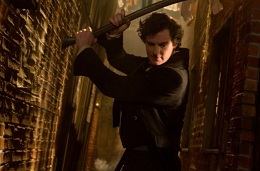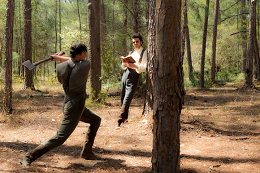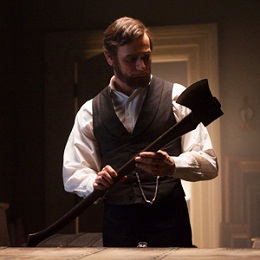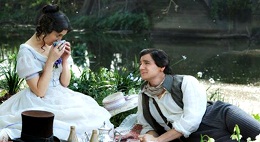Scene-Stealers contributor Warren Cantrell is a trained historian with a B.A. and M.A. in American History, and a total movie freak.
Last week, Abraham Lincoln: Vampire Hunter opened, and offered up a fun action thriller using a familiar American icon sporting some modern, ass-kicking mixed martial arts techniques against familiar, blood-sucking foes. To the casual viewer with no pretensions or hang-ups about silly summer ax-murder flicks, it is a rip-roaring good time: the cinematic equivalent to a bourbon hay-ride. Ostensibly about Lincoln’s early years and his path towards a vampire hunting career that would lead him to a life of political advocacy against slavery and the undead, the film (directed by Timur Bekmambetov) puts its foot on the gas and doesn’t let up until the final frame.
As a concept, it’s absolutely brilliant. There’s always been a lot of mystery surrounding Abe’s early years, a subject that the real Lincoln often dodged when questioned about it. In his colossal three-part narrative The Civil War, Shelby Foote said of our 16th President, “There were gaps in the story that even Herndon [an old associate] could not fill, and other gaps that no one could fill, ever, though writers were to make him the subject of more biographies than any other American.” One time, when questioned about his early years by a reporter, Abe replied with his characteristic elusiveness, “Why, Scripps, it is a great piece of folly to attempt to make anything out of my early life. It can all be condensed into a single sentence, and that sentence you will find in Gray’s Elegy: ‘The short and simple annals of the poor.’”
 For a writer with a creative, silly bend in their brain (novelist Seth Grahame-Smith), this is practically a blank check — for the unknown portions of Abe’s walkabout adolescence and early youth open up a realm of fantastic opportunities, especially for one looking to juxtapose American history with vampire lore. And while it is amusing, nay, a fucking blast watching Abe Lincoln ax the shit out of the undead in a fashion that would make Gimli, son of Gloin, proud, it’s clear that most energies and considerations went into the action set pieces, and not into detailed historical research.
For a writer with a creative, silly bend in their brain (novelist Seth Grahame-Smith), this is practically a blank check — for the unknown portions of Abe’s walkabout adolescence and early youth open up a realm of fantastic opportunities, especially for one looking to juxtapose American history with vampire lore. And while it is amusing, nay, a fucking blast watching Abe Lincoln ax the shit out of the undead in a fashion that would make Gimli, son of Gloin, proud, it’s clear that most energies and considerations went into the action set pieces, and not into detailed historical research.
And that’s fair. If you go into Abraham Lincoln: Vampire Hunter looking for a balanced, thoughtful portrayal of a historical topic, then you’re either certifiably insane, or very confused. Still, there were a surprising number of folks who were curious about the film’s accuracy, and as a person with not one, but two American History degrees, your humble author often (to his delight) gets thrown these sorts of inquiries. So, just to have a little fun, and with the understanding that this author believes that everyone should see Abraham Lincoln: Vampire Hunter, regardless of the issues presented today, I present for your consideration five things that the film got right, and five more that it got horribly, terribly wrong.
What it got right
10. Abraham Lincoln was actually quite skilled with an ax, by all accounts. His Indiana neighbors once recalled, “He can sink an ax deeper into wood than any man I ever saw,” while another recounted, “If you heard him felling trees in a clearing, you would say there were three men at work by the way the trees fell.” In the film, Abe (Benjamin Walker) mentions to Henry Sturgess (Dominic Cooper), his vampire-killing mentor, that he prefers an ax as his primary weapon, as he’s had a lot of experience splitting rails, something the real Lincoln was indeed famous for. Thus, Abraham Lincoln slicing up dozens of vampires with an ax seems entirely appropriate considering the real man, and what the record suggests of his actual physical abilities. Indeed, while Bruce Catton and other revered Civil War historians never spoke about our 16th President felling bloodthirsty creatures of the night along with stocks of timber, the stretch is an entertaining and entirely appropriate one that is enough to make any history geek blush a little.
9. Lincoln’s birth mother, Nancy Hanks Lincoln, died of milk sickness, formerly a mysterious, unaccounted-for ailment that could easily be interpreted as a slow vampire death in the grand tradition of gothic lore. In a somewhat clever move, the genuine symptoms of Nancy’s milk sickness (tremors, abdominal pain, vomiting, and delirium) are used to illustrate her condition after a vampire attack, one that fuels Abe on his quest to rid the world of the bloodthirsty creatures. Though modern science has since concluded that milk sickness is the result of consuming dairy products from a cow that’s eaten the poisonous white snakeroot, theories of the era weren’t much more sophisticated than the diagnosis offered in this film. Indeed, on the frontier, before modern medical science, what Nancy died from might very well have been considered the work of an evil entity, one whose mysterious symptoms seemed to fit the whispered rumors concerning nefarious creatures lurking in the shadows.
8. By the most basic standards of measurement, the film does a fine job portraying the landscape and architecture of 1860’s Washington, D.C., taking the time to offer mock-ups of the unfinished Capitol Dome and Washington Monument in a most precise state. In the film, the surrounding areas skirting the Capitol are shown to be marshy, largely undeveloped tracts of swamp land, an entirely accurate depiction of a city that grew out of a bog. Small details like these, and the attention given to Abe’s facial hair, which is accurately shown only after he assumes the Presidency, lend a little credence to a picture that clearly isn’t looking to impress the history buffs of the world whilst still entertaining them.
7. Abraham Lincoln was a rough, coarse, hard-bitten man of the frontier, and knew a thing or two about hands-on fighting. Take as an example one of Lincoln’s first political speeches, when a fight broke out in the crowd in front of the candidate, one Abe personally broke up before getting back on his stump to finish his speech. Even earlier than this, ol’ Abe had earned a reputation as a man not to be trifled with, for at one point he was challenged to and won an old-tyme wrestling match against a local gang of hoodlums. All of this speaks to a man who could easily be imagined as an ax-wielding agent of truth and justice, for while the historical record doesn’t suggest that Lincoln used his physical abilities to any supernatural end, it does testify to the man’s brawn and impressive physical stature, one the film made good use of during the action vignettes.
6. During the American Civil War, Lincoln practically lived in the telegraph office, and was a hands-on micromanager for the Union cause. As a President, Abe routinely worked on just three or four hours of sleep (often less), and when his armies were engaged in heavy fighting, he’d often pace behind wireless operators waiting to transcribe messages from the front: communiqués ravenously devoured by a President hanging on every word. During the latter third of Abraham Lincoln: Vampire Hunter, the title character is indeed set up in the telegraph office, much like his historical counterpart, awaiting every dispatch about the Gettysburg engagement with bated breath. This development fuels the dramatic climax, for Lincoln rushes to get silver munitions to his troops before the dramatic third-day push at Gettysburg; yet it also acts as one of the most glaring historical gaps in the script, for the film treats the engagement in eastern Pennsylvania in an embarrassingly inaccurate light, leading us to…
What the movie got so very, very wrong
5. Gettysburg was an accidental battle, and as an engagement was nebulous and improvised. In this way, Lincoln could not have known it would last three days; indeed, for those Union troops in Gettysburg on the morning of July 3, 1863, the third day of battle, there was anything but an air of certainty about what would happen in the coming hours. Though he’d come close to a breakthrough on the left, near the Round Tops, Robert E. Lee had failed to penetrate the Union fish-hook line after the second day, and had actually been advised by his chief subordinate, General Longstreet, to withdraw so as to force a pursuit and subsequent engagement on ground of the Confederates’ choosing. Though the Rebels had indeed pushed the Federal troops back during the first day of fighting (July 1), by the time Lincoln got word of the action, he had no idea how nasty a fight the country was about to endure. Indeed, by the time Lincoln realized his Army of the Potomac was facing off against three full infantry corps under the direct command of Lee, the second day of fighting was finished and the issue would have seemed somewhat secure (an assumption that the third day of fighting would not disrupt).
 Now, if the movie wanted to show an astonishing Northern reversal at the hands of a seemingly mystical, supernatural foe, I’m curious why they didn’t use Stonewall Jackson’s May 2 flank attack at Chancellorsville, one that came as close to any assault during the entire war in routing and annihilating an entire army. This Union defeat, one that came against the same army faced at Gettysburg two months later, was the kind of cluster-fuck that could easily be assigned to some sort of vampiric invasion. If Chancellorsville was used as the catalyst to start collecting silver, and the fight at Gettysburg just a few weeks later was shown as the turning point for the war because it was the fight where the vampire hordes were turned back, this humorous marriage of fact and fiction might have worked. As it stands, the timeline and assumptions about the dynamics of the battle just don’t quite fit, for it seems a stretch to believe that Lincoln could have ordered, manufactured, and delivered an entire army’s worth of munitions in just twenty four hours.
Now, if the movie wanted to show an astonishing Northern reversal at the hands of a seemingly mystical, supernatural foe, I’m curious why they didn’t use Stonewall Jackson’s May 2 flank attack at Chancellorsville, one that came as close to any assault during the entire war in routing and annihilating an entire army. This Union defeat, one that came against the same army faced at Gettysburg two months later, was the kind of cluster-fuck that could easily be assigned to some sort of vampiric invasion. If Chancellorsville was used as the catalyst to start collecting silver, and the fight at Gettysburg just a few weeks later was shown as the turning point for the war because it was the fight where the vampire hordes were turned back, this humorous marriage of fact and fiction might have worked. As it stands, the timeline and assumptions about the dynamics of the battle just don’t quite fit, for it seems a stretch to believe that Lincoln could have ordered, manufactured, and delivered an entire army’s worth of munitions in just twenty four hours.
4. Abraham Lincoln was tall…like really tall, son! Standing at an imposing 6’4’’, Lincoln was a towering figure in an era where the average male height was roughly a foot shy of his measure. In Abraham Lincoln: Vampire Hunter, the title character never seemed to stand too far above his contemporaries, and aside from a quick remark about the young man “growing,” and another gag where Mary Todd stands on her hat to get a kiss, Abe’s height never seems to come into play. This is a curious omission considering all the mileage the film could have gotten out of this entirely genuine feature, for in a movie that has the President hacking the shit out of nearly every bloodsucker in sight, the man’s considerable reach-advantage never seems to add anything into the mix. Here and there, when the framing of a shot doesn’t include Lincoln’s feet, he seems to stand a bit taller than everybody else, yet this height-difference is inconsistent and comes and goes sporadically as the picture develops: never doing justice to a man that hovered above the world like a modern N.B.A. center.
3. Pretty much everything about Mary Todd (Mary Elizabeth Winstead) was wrong. Contrary to what’s shown in the film, Abraham and Mary’s first few encounters were stilted, awkward occasions, ones the real Abe considered more of a chore rather than the product of genuine affections. She most certainly DID NOT inspire Lincoln into politics, and while she was indeed courted by Lincoln’s future rival, Stephen Douglas, her relationship with Abraham was one characterized by cold, arms-length encounters. During the Civil War, Mary Todd did play the part of the dutiful First Lady, and did sometimes accompany her husband on trips into the field to visit soldiers, yet she was hardly the steely-eyed heroine presented in this film, and certainly never made any solo trips to the front (at least not by any historical account).
No, in reality, Mary Todd was a short, squat woman who was often criticized for her lavish spending and elaborate White House receptions during periods of severe national distress. After the death of their son Tad (portrayed in the film as the victim of a vampire attack), Mary was by all accounts inconsolable, and was hardly the steadfast and resolute partner that’s portrayed in Abraham Lincoln: Vampire Hunter. No, in real life, following the death of Tad, the already eccentric and bi-polar Mary withdrew even deeper into the shadows, and became obsessed with spiritual mediums to such an extent that she developed into more of a liability to the President than an asset. Oh, and speaking of Tad, I’ll make this next one short and sweet…
2. Tad Lincoln had a cleft palate, and spoke with a lisp. In the film, though he’s only onscreen for a couple of minutes, and has just a few lines of dialogue, this medical condition isn’t accurately portrayed, something that could have easily been pulled off with a speech coach and a little make-up. Come on, Bekmambetov! That one was easy!
1. After his mother’s death, Abraham Lincoln was raised by his father’s second wife, Sarah Bush Johnson, and developed a very close and important bond with the woman that, by Abe’s own account, played a huge role in his development. Abraham would refer to Sarah as “mother” throughout the rest of his life, a historical development that is glazed over in Abraham Lincoln: Vampire Hunter, mostly as a way to give the title character more motivation for his vampire hunting deeds. Now, as we discussed, while the movie did a damn fine job mixing the historical evidence surrounding Nancy’s death with vampiric lore, its omission of Sarah in the face of a major mother-plot-point is an odd one, and something that probably is going to give Lincoln-enthusiasts fits for decades.











{ 6 comments }
Warren,
This article is great! I really enjoyed how you were able to take the subject seriously (sort of). It was a great read. Well done.
What i wondered about was the lifelong friendship between Abe and William, the black slave who becomes a Whitehouse advisor
Or the accuracy of Abe’s axe having a rifle built in! Lol
What about the sliver that was collected?
I was just curious about the point of, Heir William walles aka Willies, mysterious death as quoted in movie, was the result of a vampire bite. Similarly there is no evidential report of Willies death I guess. I think the mystery of Willies death is a point.
Excellent, and entertaining summary of a great movie plus some additional education for me on American History, many thanks. Great
Comments on this entry are closed.